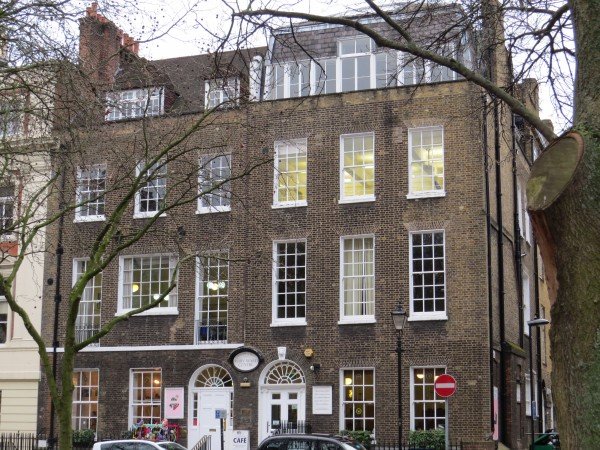Holborn Station - Bedford Row - Great James Street - Rugby Street - Lambs Conduit Street - Great Ormond Street - Queen Square - Old Gloucester Street - Red Lion Square - Holborn Station (about 1 hour)
Emerging from Holborn Underground Station, you must cross High Holborn and walk for a few hundred yards eastwards to get to Bedford Row. You do see some good buildings en route: on the south side a very early Modernist office building by Frederick Etchells, no. 233 (1930) and the grand Edwardian former Pearl Assurance buildings by Moncton & Newman (1912-19) and on the north, Turnstile House of the interwar period (look upwards) and Templar House to represent postwar historicism (1959). Go on past Red Lion Street and Hand Court, then take refuge in the byway of Brownlow Street, where there are some good traditionalist buildings as you approach Bedford Row, the first of the true highlights of this walk. This was developed by the speculative builder Nicholas Barbon, beginning in around 1690, the east side dating from 1717-19, as a follow-up to his Red Lion Square development. As you head north up Bedford Row you will begin to see that although it still seems complete, there are large redeveloped parts, particularly in the lower part of the west side and in the top half on both sides, which, though carefully done, are of little interest compared with the original houses, of which there are still many, good examples being nos. 8-17 on the east side and 34-36 and 42 on the west.
Crossing the busy Theobalds Road, you come to Great James Street, perhaps the very best of the early Georgian terraces, with their pretty fanlights, moulded flat canopies, and flush windows with arched tops, the canopies and windows being signs of early houses built before the tighter fire regulations took effect.

These houses date from the early eighteenth century. At the top end, turn left into Rugby Street, of the same period, a more modest but also most attractive display of early Georgian building. Note in particular nos. 12-18.

From here you enter Lamb's Conduit Street, originally developed by Barbon from 1690 but now refronted or later, which also has an engaging Georgian atmosphere with some attractive shopfronts, repaying a walk along both sides. Turn south, where highlights include some good houses towards Dombey Street both on the east and the west sides, then head back northwards. At the end where it becomes Guilford Place, there are more Georgian houses on the east side.
Retracing your steps, turn left into Great Ormond Street, another feast of Barbon, particularly at the eastern end.

Then go back along the street, straight across Lambs Conduit Street into the western part, and here on the south side there are more good houses, for example nos. 41 and 49, though you have to make an effort to avert your eyes from the intrusion of the hospital buildings on the north side.

Now carry on westwards into one of Bloomsbury's many attractive garden squares, Queen Square.
This was also originally developed by Barbon, planned in the 1680s when it was on the very edge of the countryside to the north and west, but it is now transformed by large institutional buildings, though there is some good architecture among these. Along the east side, they include the National Hospital for Neurology, 1880 by J.W. Simpson, ornamental terracotta, and a south extension by Slater Moberley & Uren, 1937-8, characteristic of the interwar years. Then the Royal London Homeopathic Hospital, 1843-5 by W.A. Pite. To the south, the former Italian Hospital, 1898-9 by TW Cutler. To the west of the square, the Georgian Art Worker's Guild, so important for the Arts & Crafts movement, and the Church of St. George the Martyr, founded in 1705, spruced up by Hawksmoor in 1718 and greatly altered by Teulon in 1867-8, a holy combination of the Baroque and the Gothic. It was made a parish church in 1723 as Bloomsbury expanded, one of its rectors being the antiquarian William Stukeley. Next to the church on the south side, nos. 42-43, now the Mary Ward Centre, have good Georgian features.

These buildings abut Old Gloucester Street, and if you head back south along this apparently unpromising and narrow street you find that it contains buildings of unexpected interest.

There is a sprinkling of the Victorian High Gothic that is not abundant in Bloomsbury, in the shape of the former St. George's Boys School next to the church, and down the street the austere former Girls' and Infants' School, by Teulon, slightly earlier. Opposite, and some way further down on the west side, some Georgian facades remain.
You now have to negotiate the maelstrom of Theobalds Road and Drake Street, in order to reach the oasis of Red Lion Square to the south. This was perhaps Barbon's first development, of the early 1680s, now very much altered, but there are still some quite early houses remaining on the south side, of which no.17 was inhabited by D.G. Rosetti, and later also by his fellow Pre-Raphaelite Edward Burne-Jones together with the great designer and conservationist William Morris, who used it as his office. To the west of these is the delightful faience-faced office block Summit House by Joseph Emberton (1925) which shows there is no reason why commercial buildings cannot be as excellent as any other. At the north east side of the square, one of the originally planned diagonal routes that once radiated from the square, Lambs Conduit Passage, still remains. Walking south down Dane Street from Red Lion Square, turning right and then left, you can get back into High Holborn and make your way to Holborn Underground Station.
Anthony Jennings 2012